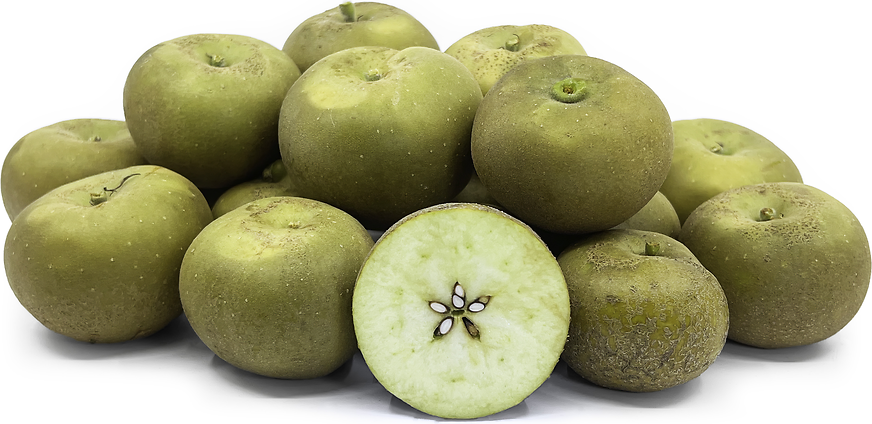


Patte de Loup Apples
Estimated Inventory, lb : 0
Description/Taste
Patte de Loup apples are irregularly shaped fruits that widely vary in appearance from round, conical, to oblate in shape, sometimes also dented or lopsided. The skin ranges in color from yellow, light brown, to yellow-green and is firm, tough, and coarse, occasionally covered in a grey-brown russet. Some apples may also crack during growth, creating a narrow, prominent scar across the surface of the fruit. Underneath the skin, the ivory flesh is dense, crisp, and aqueous, encasing a central core filled with very small, brown-black seeds. Patte de Loup apples are aromatic and have a balanced, sweet-tart flavor with subtly perfumed notes of aniseed and lychee.
Seasons/Availability
Patte de Loup apples are harvested in the late fall through winter, and when properly stored, the apples can be kept through mid-spring.
Current Facts
Patte de Loup apples, botanically classified as Malus domestica, are a very old French heirloom that belongs to the Rosaceae family. Translating from French to mean “wolf’s paw,” Patte de Loup apples earned their unusual name from the elongated scar running across the fruit. Legend has it that the apple looks like it has been scratched by a wolf. The irregularly shaped apples are also commonly known as Griffe de Loup and Pomme de Loup across France, and Patte de Loup apples are not commercially cultivated due to market demand for unblemished, uniform, and glossy-skinned fruits. Despite their distinct appearance, Patte de Loup apples have a sweet-tart flavor that is highly valued among specialty growers and home gardeners for its taste, consistency, and ability to be used in a wide variety of culinary applications.
Nutritional Value
Patte de Loup apples are a good source of vitamin C, which is an antioxidant that can help protect the immune system against external environmental aggressors. The apples also contain fiber, vitamin A, and potassium, which can help regulate fluid levels within the body.
Applications
Patte de Loup apples are best suited for both raw and cooked applications such as baking and stewing. The irregularly shaped apples have a sweet, tangy flavor that is showcased when consumed fresh, out-of-hand, and the flesh is commonly sliced and served with dips, chocolate, or cheeses on appetizer plates. The apples can also be pressed into juices and ciders, chopped and folded into crepes, or sliced and tossed into fruit and green salads. In addition to raw applications, Patte de Loup apples are known for their flavor and consistency in cooked preparations and can be made into chutney, diced into sauces, stewed into a fricassee, or roasted with meats as an accompaniment. The apples are also used in pastries and can be baked into cakes, tarts, profiteroles, and pies. Patte de Loup apples pair well with meats such as lamb, venison, beef, pork, poultry, and fish, potatoes, arugula, fennel, herbs such as thyme, parsley, and mint, vanilla, caramel, and cheeses such as cheddar, gouda, and parmesan. The fresh apples will keep 1-4 months when properly stored in a cool, dry, and dark place.
Ethnic/Cultural Info
Patte de Loup apples have been cultivated since the middle ages in France and were rumored to have been grown in the gardens of the Versailles Palace during the reign of Louis XIV. Despite their noble reputation, with the continued release of improved cultivars, Patte de Loup apples faded from local markets due to their unusual shape and have remained localized to specialty growers for many decades. In the last few years, there has been an heirloom apple revival in France, notably through organic growers that are seeking to cultivate varieties with excellent flavor. The variety is being showcased at farmer’s markets, where growers are encouraging consumers to look beyond initial appearances and favor apple varieties for their taste and texture.
Geography/History
Patte de Loup apples were first discovered in Beaupreau, a commune in the Marie-et-Loire department of Western France. The variety has been cited in horticultural documents since the 17th century but is believed to have been cultivated even earlier, dating back to the Middle Ages. Mainly popular during the 17th and 18th centuries in France, Patte de Loup apples fell out of favor in commercial markets due to their unusual appearance and are primarily found through specialty growers and home gardens in France and Europe in the modern-day.











